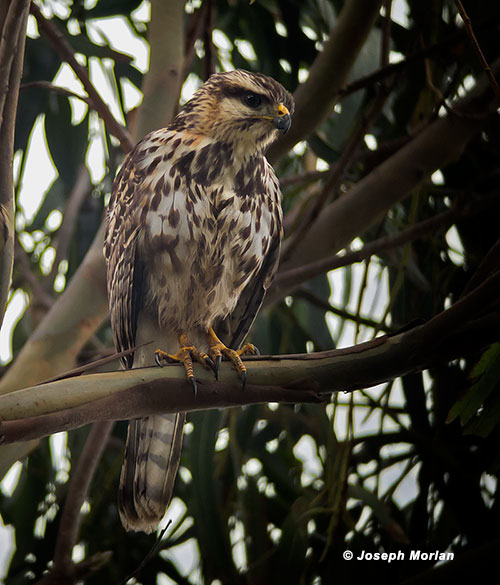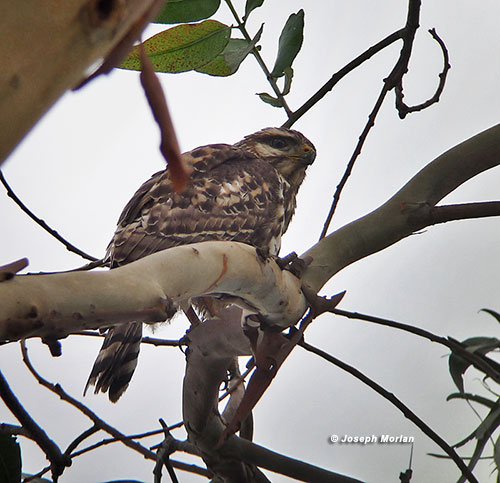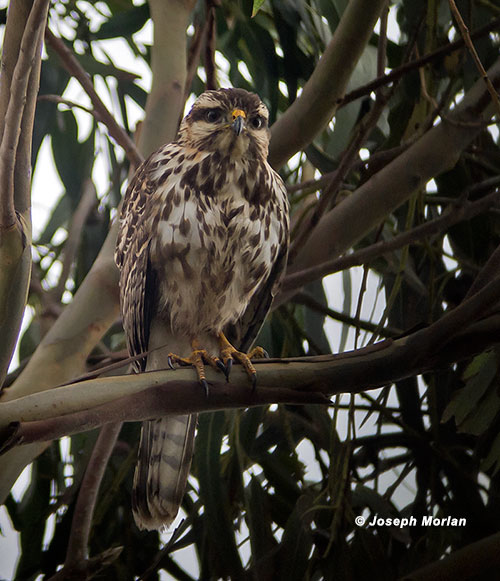Gray Hawk (Buteo plagiatus)
Carpinteria, Santa Barbara County CA
3 December 2012
Joseph Morlan
Photos © 3 December 2012 by Joseph Morlan. All rights reserved (Higher resolution images).
 This individual was found 25 November 2012 by Eric Culbertson. I arrived at the spot at 10am,
but could not find the bird. I met Bruce Henderson and another birder who had seen the Gray Hawk around noon at
the Seaside Gardens nursery on Via Real. Unfortunately the bird was flushed by a visitor to the nursery and the
hawk had flown back across the freeway to the railroad tracks adjacent to Santa Claus Lane. Bruce and I continued
to look for the bird. Around 1pm I noticed several American Crows disturbing a brownish raptor in a Eucalyptus
tree behind the Rincon Beach Club. I alerted Bruce who was much closer and he confirmed it was the juvenile Gray
Hawk. I quickly attempted to photograph the bird and was fortunate to get some decent images digiscoped with Panasonic
DMC-LX5 | Nikon FieldScope III | 30XWA | hand-held (no adapter).
This individual was found 25 November 2012 by Eric Culbertson. I arrived at the spot at 10am,
but could not find the bird. I met Bruce Henderson and another birder who had seen the Gray Hawk around noon at
the Seaside Gardens nursery on Via Real. Unfortunately the bird was flushed by a visitor to the nursery and the
hawk had flown back across the freeway to the railroad tracks adjacent to Santa Claus Lane. Bruce and I continued
to look for the bird. Around 1pm I noticed several American Crows disturbing a brownish raptor in a Eucalyptus
tree behind the Rincon Beach Club. I alerted Bruce who was much closer and he confirmed it was the juvenile Gray
Hawk. I quickly attempted to photograph the bird and was fortunate to get some decent images digiscoped with Panasonic
DMC-LX5 | Nikon FieldScope III | 30XWA | hand-held (no adapter).
Description
The following description is based on memory and on photos:
A small juvenal plumage hawk, slightly smaller than Red-shouldered Hawk, but larger than American Crow. The
head was boldly patterned with a creamy face set off with a dark mask. A light tan supercilium contrasted with
a dark cap which extended to the forehead. The throat was light tan with two short lateral throat stripes and a
short mid-throat line extending down the middle of the throat. The rear of the ear coverts were tawny brown suffused
with fine dark streaks.
The underparts were whitish with extensive teardrop shaped streak/spots uniformly distributed throughout
except on either side of the chest where the spots were larger and darker. The upperparts were extensively brown
and heavily mottled with light tan and rich buff forming a very complex pattern. The underside of the tail was
gray with a broad wavy subterminal band and multiple progressively narrower bands extending to the base of the
tail. The tip of the tail was slightly worn. The eye and bill were dark. The cere and feet were yellow with an
orange cast.
In flight the underwings were whitish, only faintly marked with brown, recalling the pattern of Broad-winged
Hawk, but lacking a dark trailing edge. The tips of the uppertail coverts were white forming a "U" shaped
white band at the base of the tail. In flight the wings were held relatively flat with the wing-tips angling slightly
up.
Distribution
This individual has been present daily since 25 November 2012 when found by Eric Culbertson. This species normally
ranges from Mexico locally to southeastern Arizona and southern Texas. Otherwise I am aware of two records of adults
from Kansas, an adult in Baja California Sur in Oct. 2010; and a report from Illinois in 1871.
This species is hypothetical in California based on the following two sight-records, neither of which were accepted
by the CBRC.
- 16 Jun 1984 Bolinas MRN 1985-021
- 10 May 2012 Marin Headlands MRN 2012-072
In addition, Rich Stallcup reported seeing an adult Gray Hawk soaring at East Fort Baker, Marin County on April
25, 2005 (Pacific Raptor Report 26:19, 2005). This
sighting has not yet been reviewed.
Taxonomy
This species was formerly placed in the genus Asturina and more recently had the specific name Buteo
nitidus. In the most recent 53rd Supplement (PDF)
the AOU split the Gray Hawk (Buteo nitidus) into two species, northern Gray Hawk (Buteo plagiatus)
and southern Gray-lined Hawk (Buteo nitidus) citing a 2011 publication by Milsap et al. (PDF).
Although the Gray-lined Hawk has not been recorded north of Costa Rica, it is useful to distinguish this bird from
that species which might occur as an escape from captivity.
Status in Captivity
I queried the ISIS database and received
a report that 17 Gray Hawks (Buteo nitidus possibly including Gray-lined Hawks) are held in captivity in
various institutions: eleven in Guatemala, four in Mexico, one in Europe, and one adult female in the United States
(Arizona/Sonora Desert Museum). I also checked reports of lost/found raptors on the North
American Falconers Exchange web site. At this time they do not report any lost or found Gray Hawks.
Identification
Milsap et al. offer eight plumage differences between juveniles of Gray-lined vs. Gray hawk as
follows
| |
Gray-lined Hawk |
Gray Hawk |
| Crown |
Buffy, dark streaks |
Dark brown |
| Auricular |
Buffy |
White |
| Malar stripe |
Absent |
Dark, pronounced |
| Breast, belly |
Buffy, dark blobs |
White, narrow dark streaks |
| Crural |
Buffy, unmarked |
White, narrow dark bands |
| Primaries, upper surface |
Large buffy light patch |
Dark brown, no patch |
| Rectrices, upper surface |
Base whitish, wide bands |
Base brown, narrow bands |
| Upper tail coverts |
Buffy |
White, dark shaft streaks |
The term "crural" refers to the feathers of the tibia. Our bird seems to better fit Gray Hawk and
not Gray-lined Hawk in all eight. Most noticeable are the dark forehead, larger number of tail bars and more uniform
pattern of the underparts of Gray Hawk. More detail and a useful color plate is in the Milsap paper linked above..
Gray-lined Hawk aside, as a practical matter, the juvenal plumage of the Gray Hawk is most similar to that of
Broad-winged Hawk (Buteo platypterus). The latter is slightly smaller and usually has a less pronounced
face pattern, but some Broad-wings have a strong eyebrow. Broad-winged is shorter tailed, and its tail bands are
fewer and thicker than Gray Hawk. Broad-wing usually has darker cheeks, a darker outline to the posterior edge
of the underwing; and it also has more pointed wings and subtly different shape. At least one prior claim of Gray
Hawk in California (5 July 1998 at Baker Creek Riparian Area, Inyo County) was retracted after a Broad-winged Hawk
was seen there the next day.
Outside Links
- 25 November
- 26 November
- 27 November
- 28 November
- 29 November
- 30 November
- 1 December
- 2 December
- 3 December
- 4 December
- 6 December
- 8 December
- 9 December
 This individual was found 25 November 2012 by Eric Culbertson. I arrived at the spot at 10am,
but could not find the bird. I met Bruce Henderson and another birder who had seen the Gray Hawk around noon at
the Seaside Gardens nursery on Via Real. Unfortunately the bird was flushed by a visitor to the nursery and the
hawk had flown back across the freeway to the railroad tracks adjacent to Santa Claus Lane. Bruce and I continued
to look for the bird. Around 1pm I noticed several American Crows disturbing a brownish raptor in a Eucalyptus
tree behind the Rincon Beach Club. I alerted Bruce who was much closer and he confirmed it was the juvenile Gray
Hawk. I quickly attempted to photograph the bird and was fortunate to get some decent images digiscoped with Panasonic
DMC-LX5 | Nikon FieldScope III | 30XWA | hand-held (no adapter).
This individual was found 25 November 2012 by Eric Culbertson. I arrived at the spot at 10am,
but could not find the bird. I met Bruce Henderson and another birder who had seen the Gray Hawk around noon at
the Seaside Gardens nursery on Via Real. Unfortunately the bird was flushed by a visitor to the nursery and the
hawk had flown back across the freeway to the railroad tracks adjacent to Santa Claus Lane. Bruce and I continued
to look for the bird. Around 1pm I noticed several American Crows disturbing a brownish raptor in a Eucalyptus
tree behind the Rincon Beach Club. I alerted Bruce who was much closer and he confirmed it was the juvenile Gray
Hawk. I quickly attempted to photograph the bird and was fortunate to get some decent images digiscoped with Panasonic
DMC-LX5 | Nikon FieldScope III | 30XWA | hand-held (no adapter).
